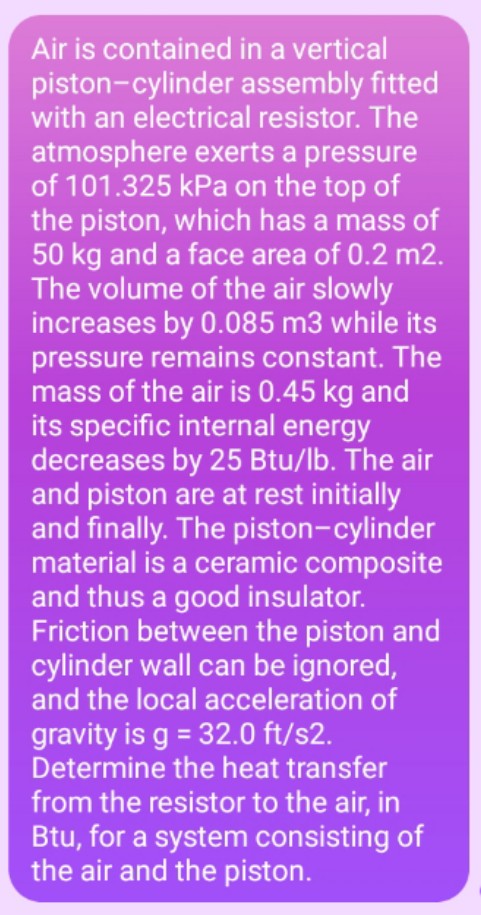Air is contained in a vertical piston-cylinder assembly fitted with an electrical resistor. The atmosphere exerts a pressure of 101.325 kPa on the top of the piston, which has a mass of 50 kg and a face area of 0.2 m2. The volume of the air slowly increases by 0.085 m3 while its pressure remains constant. The mass of the air is 0.45 kg and its specific internal energy decreases by 25 Btu/lb. The air and piston are at rest initially and finally. The piston-cylinder material is a ceramic composite and thus a good insulator. Friction between the piston and cylinder wall can be ignored, and the local acceleration of gravity is g = 32.0 ft/s2. Determine the heat transfer from the resistor to the air, in Btu, for a system consisting of the air and the piston.
Air is contained in a vertical piston-cylinder assembly fitted with an electrical resistor. The atmosphere exerts a pressure of 101.325 kPa on the top of the piston, which has a mass of 50 kg and a face area of 0.2 m2. The volume of the air slowly increases by 0.085 m3 while its pressure remains constant. The mass of the air is 0.45 kg and its specific internal energy decreases by 25 Btu/lb. The air and piston are at rest initially and finally. The piston-cylinder material is a ceramic composite and thus a good insulator. Friction between the piston and cylinder wall can be ignored, and the local acceleration of gravity is g = 32.0 ft/s2. Determine the heat transfer from the resistor to the air, in Btu, for a system consisting of the air and the piston.
Elements Of Electromagnetics
7th Edition
ISBN:9780190698614
Author:Sadiku, Matthew N. O.
Publisher:Sadiku, Matthew N. O.
ChapterMA: Math Assessment
Section: Chapter Questions
Problem 1.1MA
Related questions
Question
100%

Transcribed Image Text:Air is contained in a vertical
piston-cylinder assembly fitted
with an electrical resistor. The
atmosphere exerts a pressure
of 101.325 kPa on the top of
the piston, which has a mass of
50 kg and a face area of 0.2 m2.
The volume of the air slowly
increases by 0.085 m3 while its
pressure remains constant. The
mass of the air is 0.45 kg and
its specific internal energy
decreases by 25 Btu/lb. The air
and piston are at rest initially
and finally. The piston-cylinder
material is a ceramic composite
and thus a good insulator.
Friction between the piston and
cylinder wall can be ignored,
and the local acceleration of
gravity is g = 32.0 ft/s2.
Determine the heat transfer
from the resistor to the air, in
Btu, for a system consisting of
the air and the piston.
Expert Solution
This question has been solved!
Explore an expertly crafted, step-by-step solution for a thorough understanding of key concepts.
This is a popular solution!
Trending now
This is a popular solution!
Step by step
Solved in 3 steps

Knowledge Booster
Learn more about
Need a deep-dive on the concept behind this application? Look no further. Learn more about this topic, mechanical-engineering and related others by exploring similar questions and additional content below.Recommended textbooks for you

Elements Of Electromagnetics
Mechanical Engineering
ISBN:
9780190698614
Author:
Sadiku, Matthew N. O.
Publisher:
Oxford University Press

Mechanics of Materials (10th Edition)
Mechanical Engineering
ISBN:
9780134319650
Author:
Russell C. Hibbeler
Publisher:
PEARSON

Thermodynamics: An Engineering Approach
Mechanical Engineering
ISBN:
9781259822674
Author:
Yunus A. Cengel Dr., Michael A. Boles
Publisher:
McGraw-Hill Education

Elements Of Electromagnetics
Mechanical Engineering
ISBN:
9780190698614
Author:
Sadiku, Matthew N. O.
Publisher:
Oxford University Press

Mechanics of Materials (10th Edition)
Mechanical Engineering
ISBN:
9780134319650
Author:
Russell C. Hibbeler
Publisher:
PEARSON

Thermodynamics: An Engineering Approach
Mechanical Engineering
ISBN:
9781259822674
Author:
Yunus A. Cengel Dr., Michael A. Boles
Publisher:
McGraw-Hill Education

Control Systems Engineering
Mechanical Engineering
ISBN:
9781118170519
Author:
Norman S. Nise
Publisher:
WILEY

Mechanics of Materials (MindTap Course List)
Mechanical Engineering
ISBN:
9781337093347
Author:
Barry J. Goodno, James M. Gere
Publisher:
Cengage Learning

Engineering Mechanics: Statics
Mechanical Engineering
ISBN:
9781118807330
Author:
James L. Meriam, L. G. Kraige, J. N. Bolton
Publisher:
WILEY